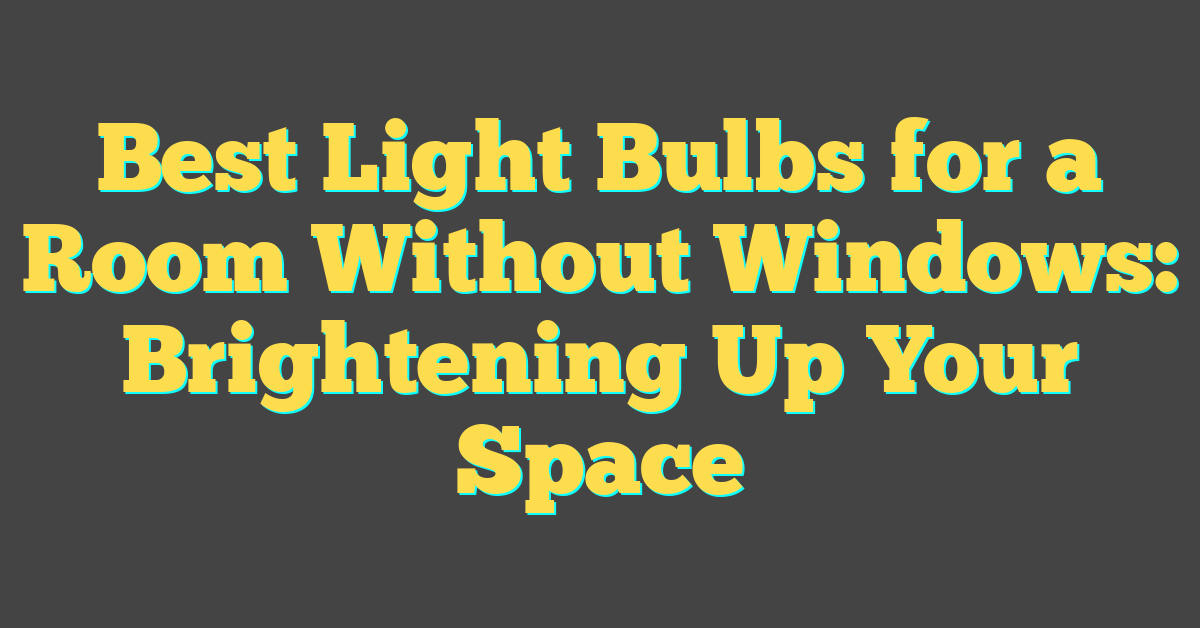Lighting plays a crucial role in the comfort and aesthetics of any interior space, and the challenge intensifies when it comes to rooms devoid of natural light. The absence of windows in a room means no sunlight, which can affect both the room’s functionality and your mood. Choosing the right light bulbs can transform such a room into a cozy and inviting space, even without the benefit of natural daylight. A well-lit windowless room requires careful consideration of bulb types, color temperatures, and luminosity to create an atmosphere that is both practical and pleasant.


In a windowless room, light bulbs that mimic natural sunlight are often the best place to start. Tunable smart bulbs, which can adjust from warm to cool white light, are particularly effective in replicating the effects of the sun. These bulbs allow you to customize lighting based on the time of day or the activity you’re engaged in, helping to maintain your circadian rhythm and enhance concentration when necessary. With the right selection, a windowless room can be converted into a functional space that feels just as comfortable and inviting as one bathed in natural light.
Key Takeaways
- Selecting the right bulbs can create a welcoming atmosphere in windowless rooms.
- Smart bulbs with adjustable color temperatures can imitate natural sunlight.
- Effective lighting enhances room functionality and supports your well-being.
Understanding Lighting Essentials
https://www.youtube.com/watch?v=oA-uLPzMilU&embed=true
In this section, you’ll gain insight into how to evaluate and choose artificial lighting options that can mimic natural light in spaces without windows.
Fundamentals of Artificial Lighting
Artificial lighting is your go-to solution when natural light is absent. Brightness, color temperature, and direction are crucial factors in creating a comfortable environment. Brightness refers to the intensity of light, usually controlled by the wattage and the type of bulb. Color temperature is measured in Kelvin and indicates whether the light is warm or cool. Direction involves where light is cast, affecting how shadows and highlights shape your space.
Measuring Light with Lumens
Lumens measure the total amount of visible light emitted by a source. The higher the lumens, the brighter the light. Unlike watts, which indicate energy consumption, lumens directly relate to the perceived brightness. For a room without windows, an LED bulb with high lumens can ensure your room is well-lit and inviting.
When selecting lighting for a windowless room, reach for bulbs that offer enough lumens to compensate for the lack of natural light. For instance, Philips Hue White ambiance bulbs offer adjustable settings to simulate the sun’s natural progression throughout the day.
Ideal Light Bulbs for Windowless Rooms

Choosing the right lighting is crucial for rooms without natural light. You’ll want bulbs that not only brighten the space efficiently but also create a comfortable ambiance.
Types of Bulbs
For windowless rooms, your bulb choices include LED, incandescent, and CFL (Compact Fluorescent Lamps). However, not all bulbs are created equal. LED bulbs offer significant benefits over the others, such as energy efficiency and longer lifespan. Philips Hue White ambiance bulbs are a popular LED option that mimic natural light with customizable settings. Incandescent bulbs, while cheaper upfront, consume more electricity and need frequent replacements. CFLs are more energy-efficient than incandescent bulbs and less so than LEDs, but they take a while to warm up to full brightness.
LED Bulbs and Their Advantages
LED bulbs stand out in windowless rooms for their energy efficiency and longevity. They use up to 90% less energy than incandescent bulbs and last up to 25 times longer. This means you won’t be changing bulbs often, which is especially convenient in challenging spaces.
Moreover, LED bulbs come in various color temperatures, from warm to cool, allowing you to create the desired atmosphere. High-quality LED options, like those from Philips Hue, can even be adjusted throughout the day to complement your activities—use a cool, bright setting for concentration or a warm, soft glow to relax.
Smart bulbs take LED advantages further, as they can be controlled remotely, set to schedules, and even adjusted with voice commands. This added layer of convenience makes smart LED bulbs an exceptional choice for windowless areas, ensuring that you get just the right amount of light when you need it.
Designing Lighting Layout

« Best Light Bulb for Room Without Windows: Brighten Up Your Space Effortlessly
Best Kind of Light Bulbs: Types to Brighten Your Home Efficiently »
When planning the illumination for your windowless space, you want to create a sense of brightness and openness. Strategic placement of lighting fixtures and leveraging reflective surfaces are key techniques to achieve that effect.
Strategic Fixture Placement
To effectively light a room with no windows, it’s important to position your lighting fixtures to cover the entire area without creating harsh shadows. Consider installing overhead fixtures in the center of the room for ambient light, and supplement with recessed lighting along the edges to eliminate dark corners. Placing table lamps on side tables or shelves can also add layers of light, enhancing the room’s depth and dimension.
Leveraging Reflective Surfaces
Utilize mirrors and other reflective surfaces to bounce light around the room, making it appear brighter and more spacious. By positioning mirrors directly across from light sources, such as beside a table lamp, you amplify the light’s reach as it will reflect light across the room. This not only maximizes the efficacy of your lighting fixtures but also yields a more natural and inviting atmosphere.
Creating a Natural Ambiance
When optimizing lighting for a room without windows, your objective is to closely replicate the feel of natural daylight, which involves understanding how light affects both color and mood.
https://www.youtube.com/watch?v=sORBqqW1Ocg&embed=true
Mimicking Daylight
To emulate the brightness of the sun, look for bulbs that offer a bright white or cool white glow, usually around 5,000 to 6,500 Kelvins. Philips Hue White ambiance bulbs, specifically designed to simulate the sun’s natural rhythm, can help you achieve this effect, providing a range of lighting modes to suit different times of the day.
Color Temperature Considerations
Color temperature is key to creating a natural atmosphere. Measured in Kelvins, it influences the perceived warmth or coolness of light. Lower temperatures, around 2,700 to 3,000 Kelvins, yield a soft white or warm white color, akin to a sunrise or sunset. Conversely, higher color temperatures equate to a bright white or cool white light, reminiscent of midday sunshine. Adjusting the color temperature to time-of-day needs can support your circadian rhythm and enhance focus or relaxation as needed.
Enhancing Small Spaces
https://www.youtube.com/watch?v=uy2gXpKpYZw&embed=true
In small, windowless rooms, strategic lighting and design can create the illusion of space. Here’s how you can maximize your area with clever tricks involving mirrors and furnishings.
Effective Use of Mirrors
Using mirrors is a smart way to make your small spaces feel larger and brighter. Position a mirror to reflect light from a Signe floor lamp; this can simulate a window effect by spreading light throughout the room. For maximum impact, consider placing mirrors across from each light source, as this can double the reach of the light.
Furniture and Layout
When it comes to furniture, less is more. Choose pieces that are proportionate to the size of your room—oversized furniture can make a small space feel cluttered. Opt for multi-functional items, like ottomans with storage, and consider using glass doors on cabinets to add depth to the room. The layout should allow for unobstructed pathways, giving the room a more open feel.
Lighting Solutions for Specific Areas

When you’re looking to illuminate areas of your home without the benefit of natural light, every bulb and fixture makes a significant difference. Your choice of lighting should be functional and enhance the aesthetics of your space, whether that be a cozy bathroom retreat or a productive office environment.
Lighting for Windowless Bathrooms
In windowless bathrooms, your goal should be to mimic natural light. Consider using LED light bulbs that offer adjustable color temperatures; bright and cool during the morning, and warm and soft in the evening. For instance, Philips Hue White ambiance bulbs are well-suited as they can change from cool to warm white light, helping you energize in the morning and relax at night. Place lights strategically around mirrors to reduce shadows and use diffused lighting to create a soft glow that reduces glare on shiny surfaces.
Office and Hallway Lighting Ideas
For your office, task lighting is key. It’s important to have focused lights, such as a desklamp, that provide you with the clarity necessary for work without straining your eyes. Ambient lighting also plays a role in reducing contrast between your computer screen and the surroundings. As for the hallway, you want lighting that ensures safety while providing a warm welcome. Wall-mounted fixtures or recessed lights can serve as ambient lighting, evenly dispersing light and eliminating any dark corners. Consider smart lighting systems that allow you to control intensity and color temperature for both settings, seamlessly transitioning from vibrant and active to calm and subdued as needed.
Technical Considerations for Bulb Selection
https://www.youtube.com/watch?v=FnCbFe2-WjY&embed=true
When selecting light bulbs for a room without windows, two technical details are crucial: the Color Rendering Index (CRI) and bulb wattage. These factors affect how light will perform in your environment, influencing everything from mood to color accuracy.
Understanding Color Rendering Index
The Color Rendering Index (CRI) is a scale from 0 to 100 that measures a light source’s ability to show colors truthfully when compared to natural light. The higher the CRI, the better the artificial light will render colors. For rooms without windows, you’ll want to opt for bulbs with a high CRI, as there is no natural light to help balance and reveal true colors. Bulbs with a CRI of 80-90 are considered good, but for the best results, look for bulbs closer to 100 on the CRI scale.
The Importance of Bulb Wattage
Wattage is related to a bulb’s energy consumption and its brightness; however, with advancements in technology, energy efficiency has changed the way we think about wattage. Instead of equating higher wattage with more brightness, consider the lumens—a measure of actual light output. For a space lacking natural light, you’ll need bulbs with sufficient lumens to illuminate the area well. Keep in mind that LED bulbs use fewer watts to produce the same level of brightness as their incandescent counterparts, so they can save on your energy bill in the long run while providing the lighting you need.
Decorative Lighting Elements

When it comes to lighting up a room with no natural light, the decorative elements you choose can turn basic illumination into an aesthetic statement. Beyond function, lighting fixtures can be the jewelry of your space, adding sparkle and personality.
Accent Lighting Options
Accent lighting plays a crucial role in layering the light in your windowless room. Table lamps and floor lamps offer both functionality and decorative appeal, providing you with the opportunity to infuse character through various designs and styles. Aim to select lamps that complement your room’s decor while casting an inviting glow.
For a more modern and sleek look, consider wall sconces. They not only save space but also create focal points that can highlight artwork or architectural features within your room. Track lighting, on the other hand, is flexible and can be adjusted to point light exactly where it’s needed, making it ideal for accentuating objects or areas within the space.
Choosing the Right Chandelier
When selecting a chandelier for your room, consider both size and style. A statement chandelier serves as a centerpiece and can make a room feel more grounded and intentionally designed. Ensure the scale of the chandelier complements the room without overwhelming it. Small to medium-sized rooms will benefit from simpler, more compact chandelier designs, while larger spaces can accommodate grander models.
Pendants can also serve a similar purpose, especially when clustered or arranged in an artistic formation. These can be especially effective over a specific area like a reading nook or dining table within your windowless room. Opt for pendants with translucent or reflective materials to amplify the light they cast.
Smart Lighting and Automation
https://www.youtube.com/watch?v=OdR8x9fh4AY&embed=true
In rooms without windows, smart lighting is your best ally. Smart bulbs like Philips Hue not only illuminate your space but also grant you control over the brightness and color, adapting to your every need with ease.
Benefits of Smart Light Bulbs
Adjustable Settings: Most smart light bulbs are dimmable, allowing you to adjust the brightness to match your desired ambiance. You can create a range of moods—from a brightly lit workspace to a cozy evening nook—with just a few taps on your smartphone or voice commands.
Energy Efficiency: These bulbs tend to use LED technology, which consumes less power and lasts longer than traditional bulbs, saving you money in the long run.
Controlling Lights Remotely
Convenience: With a dimmer switch or app, you can control your smart light bulbs from anywhere. Forgot to turn off the lights before leaving? No problem. Adjust them on the go.
Scheduling: You can set schedules for your lights to turn on and off, mimicking natural sunlight patterns, which is especially handy in rooms with no natural light source.
Addressing Common Lighting Issues
https://www.youtube.com/watch?v=MWXhMdoccu8&embed=true
When choosing light bulbs for a room without windows, it’s important to address common issues such as glare, flicker, buzz, and hum. These can all affect the quality of your lighting experience. Let’s explore ways to minimize these annoyances for a comfortable, well-lit space.
Dealing with Glare and Flicker
Glare can cause discomfort and make it difficult to see, especially if your room lacks natural light. To minimize glare, choose bulbs with a frosted cover that diffuses light evenly. For flicker, it’s important to opt for high-quality LED bulbs that provide a steady light output without visible fluctuations. Look for bulbs that are labeled as having low flicker or flicker-free performance to ensure a steady illumination in your space.
- Tips to reduce glare and flicker:
- Choose frosted bulbs to diffuse light.
- Select LEDs with low flicker labels.
Eliminating Buzz and Hum
Nobody enjoys the constant buzz or hum that some light fixtures emit. This is often due to electromagnetic interference within the electrical components. To eliminate these sounds, look for bulbs that are UL Listed, which means they have been tested for safety and function, including noise levels. Moreover, ensure that your light fixtures and bulbs are compatible since mismatched components can cause unnecessary noise.
- Strategies to avoid buzz and hum:
- Use UL Listed bulbs for noise-free assurance.
- Check compatibility between bulbs and fixtures.
Eco-friendly and Energy-Saving Tips
https://www.youtube.com/watch?v=HkHozg0ckWY&embed=true
When selecting light bulbs for a room with no natural light, it is critical to choose options that not only brighten your space but also promote environmental sustainability and energy conservation.
Energy Star Certified Bulbs
Energy Star certified bulbs are your go-to for ensuring eco-friendliness. These bulbs, which include LEDs and CFLs, are tested for energy efficiency and meet strict quality standards. LEDs, in particular, use up to 75% less energy than traditional incandescent bulbs, making them a stellar choice for rooms without windows.
- Pros of Energy Star Certified Bulbs:
- Reduce electricity use and save on energy bills.
- Long lifespan reduces the need for frequent replacements.
Long-Term Cost Savings
Investing in energy-efficient bulbs like LEDs can lead to substantial long-term cost savings. Although the upfront cost may be higher than traditional bulbs, LEDs last up to 25 times longer, which means you buy and dispose of fewer bulbs over time. This prolonged lifespan coupled with the reduced energy use results in saving money on your electricity bills.
- Financial Benefits:
- Upfront Cost: Higher than incandescent, but pays off over time.
- Maintenance Costs: Infrequent replacements due to long-lasting LEDs and CFLs.




